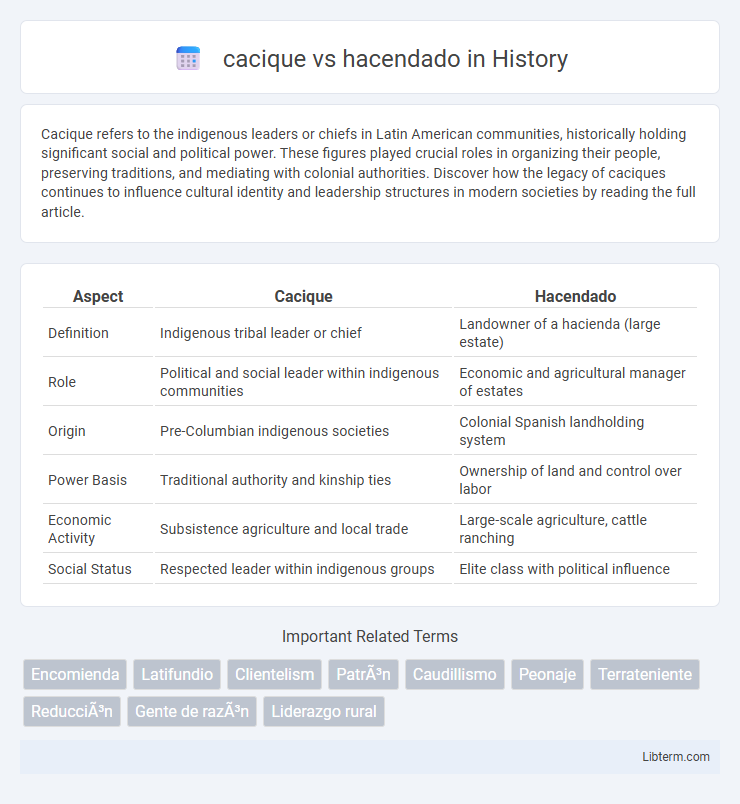Cacique refers to the indigenous leaders or chiefs in Latin American communities, historically holding significant social and political power. These figures played crucial roles in organizing their people, preserving traditions, and mediating with colonial authorities. Discover how the legacy of caciques continues to influence cultural identity and leadership structures in modern societies by reading the full article.
Table of Comparison
| Aspect | Cacique | Hacendado |
|---|---|---|
| Definition | Indigenous tribal leader or chief | Landowner of a hacienda (large estate) |
| Role | Political and social leader within indigenous communities | Economic and agricultural manager of estates |
| Origin | Pre-Columbian indigenous societies | Colonial Spanish landholding system |
| Power Basis | Traditional authority and kinship ties | Ownership of land and control over labor |
| Economic Activity | Subsistence agriculture and local trade | Large-scale agriculture, cattle ranching |
| Social Status | Respected leader within indigenous groups | Elite class with political influence |
Introduction: Defining Cacique and Hacendado
The term cacique refers to indigenous leaders or chiefs who held social and political authority within native communities, especially in Latin America during colonial and early post-colonial periods. Hacendado denotes wealthy landowners who controlled large agricultural estates, often exerting economic and political influence in rural regions. Both roles shaped power dynamics but differed fundamentally in origin, cultural context, and scope of authority.
Historical Origins and Evolution
Caciques historically served as indigenous leaders in pre-Columbian societies, wielding authority through traditional kinship and communal ties, while hacendados emerged during the Spanish colonial era as landowners controlling vast haciendas with economic and political power. The evolution of caciques reflects a shift from communal leadership to intermediaries between colonial authorities and indigenous populations, often adapting to imposed colonial systems. In contrast, hacendados consolidated wealth through agricultural production and labor exploitation, shaping socio-economic hierarchies that persisted into modern Latin American history.
Geographic Distribution and Regional Influence
Caciques historically dominated indigenous and rural areas primarily in Latin America, especially within Andean regions and Mexico, where their influence shaped local governance and social hierarchies. Hacendados, by contrast, controlled large estates (haciendas) mainly in colonial Mexico, Central America, and parts of South America, exerting economic power through agricultural production and labor exploitation. The regional influence of caciques was often localized and tied to ethnic communities, whereas hacendados impacted broader colonial and post-colonial economic structures across multiple geographic zones.
Roles in Colonial and Post-Colonial Societies
Caciques served as indigenous leaders representing their communities, often mediating between colonial authorities and local populations to maintain social order and preserve native customs. Hacendados, large landowners in colonial and post-colonial societies, controlled extensive estates and wielded significant economic and political power through agriculture and resource exploitation. The dynamic between caciques and hacendados shaped rural governance, land tenure, and indigenous rights during both colonial rule and the ensuing nation-building processes.
Social Status and Economic Power
Caciques held significant social status as indigenous leaders who controlled local communities and maintained traditional authority, often influencing regional politics and social structures. Hacendados, on the other hand, were wealthy landowners with substantial economic power derived from vast estates and agricultural production, dominating the rural economy. While caciques embodied social legitimacy through ancestry and cultural influence, hacendados exercised economic dominance backed by their extensive landholdings and capital.
Political Influence and Authority
Caciques wield localized political influence through traditional authority and control over indigenous communities, often leveraging personal networks and social capital. Hacendados hold broader economic power derived from land ownership, enabling them to influence regional politics and government policies extensively. The interplay between cacique loyalty and hacendado resources shapes hierarchical power dynamics in rural Latin American societies.
Relationship with Indigenous Communities
Caciques historically served as intermediaries between colonial or local authorities and Indigenous communities, often maintaining social, political, and spiritual leadership within their groups. Hacendados, as wealthy landowners, exercised economic and legal control over vast estates, frequently exploiting Indigenous labor through systems like encomienda or debt peonage. The power imbalance in this dynamic positioned caciques as community figures balancing Indigenous interests with hacendados' land and labor demands.
Conflicts and Collaboration Between Caciques and Hacendados
Conflicts between caciques and hacendados often centered on land control and labor exploitation, as caciques sought to maintain indigenous communal rights while hacendados aimed to expand large estates for agriculture or cattle ranching. Collaboration occasionally arose through negotiated labor arrangements and mutual benefits in resource management, with caciques facilitating local labor supply and hacendados providing economic opportunities. These interactions shaped social dynamics and economic structures in rural Latin America, reflecting ongoing tensions between traditional authority and colonial or capitalist interests.
Decline, Transformation, and Legacy
The decline of caciques and hacendados in Latin America resulted from land reforms, modernization, and state intervention diminishing their traditional power bases. Transformation occurred as hacendados shifted toward commercial agriculture and industrial enterprises, while caciques adapted by integrating into political structures or community leadership roles. Their legacy persists in shaping social hierarchies, rural inequality, and cultural identities across postcolonial societies.
Contemporary Relevance and Interpretations
Caciques and hacendados remain influential figures in contemporary Latin American socio-political dynamics, representing traditional local power and landowner elites respectively. The cacique system continues to reflect indigenous and rural leadership models, often mediating state policies and community interests, while hacendados symbolize entrenched economic authority in agrarian sectors. Current interpretations highlight the tension between these roles in land rights debates, social justice movements, and regional governance reforms.
cacique Infographic

 libterm.com
libterm.com